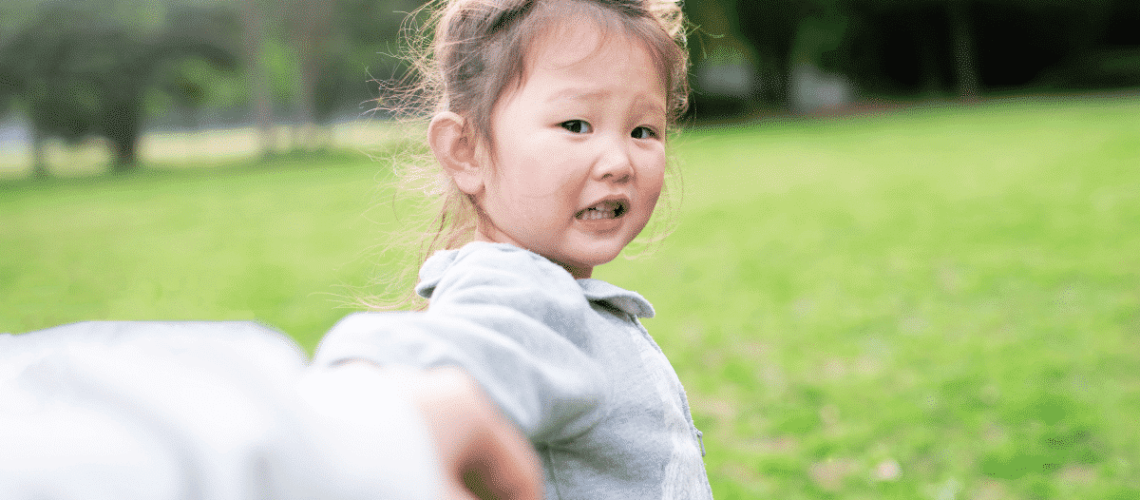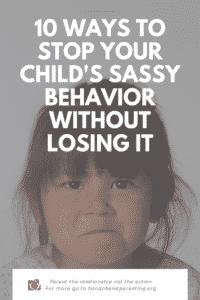Take action and stop your child's disrespectful behavior in 10 simple steps
You thought it was an easy enough question.
“Did you put your library books in your bag?”
It is, after all, the night before your six-year-old has to return her books. She does, in fact, delight in bringing new books back each week. So the last thing you expect is her response:
Hands on hips. A flick of the hair. Was that an eye-roll you saw? Ew. And that sing-songy voice?
“No. I did not put my books in my bag, mama. What are you going to do about it?”
And at that moment, you are stunned.
What are you going to do about it?
Children choose surprising ways to make their bids for connection, which is what disrespectful and attention-getting behavior is. Really! It is!
It's your child's way of saying, “Look at me,” which translates as, “Hey. I need your eyes on me.” Which translates as,” Something doesn't feel right. I need your reassurance.”
For whatever reason, at that moment, your child is not feeling 100 percent capable, confident or secure.
And even if you don't like your child's disrespectful behavior, you have to agree that it is pretty effective. It does, at least, stop you in your tracks.
Boom. Your eyes are on your child instantly.
But what behaviors like swearing, sassiness, rudeness, and defiance aren't so effective at is prompting the empathy they deserve.
Instead, those words trigger us parents in all kinds of ways. We think stuff like this:
- Ew! My child is so rude/spoiled/disrespectful.
- I would never have spoken to my parents like that.
- My parents would have throttled me if I spoke to them like that.
- I bet no-one else's kids speak like that.
- Whaaaat the…
And all of those triggers propel us to shut down. We hunt for a quick resolution. We give sassiness back or get into power struggles.
Which again ignores the underlying issue.
Disrespect is Actually A Compliment
A compliment? Actually, yes. Here's why…
When children feel safe around their loved ones, they feel safe enough to show you ALL their feelings. That's why even though your child's teacher says he's great in class, he falls apart with you after school every day.
It's why your child's dance teacher says she's great at paying attention, and then it feels like you are talking to a blank screen when you try to make conversation with her at dinner. Or when you ask your child to put away the football kit and they kick it across the living room.
Kids put out these bids for your attention that they wouldn’t dare try in other places, like school or a dance class. It’s a compliment to you that you've created an emotionally safe environment, where your child trusts that they don’t always have to hide the tensions they feel.
These ways are the obscure ways that kids show you they don't feel so good about what's going on in their lives at that moment. It's just that they land a little off. Well, okay, a lot off sometimes.
Is that so very different from when your partner sees you slamming cupboard doors in the kitchen and asks if he can help, and you, so annoyed by whatever got you upset, harshly say “No,” and then slam a few more doors?
You love that your partner asked, but you are so wound up you know you'll blow if you even try to explain what went wrong.
When kids are disrespectful they are sharing information. Information that they aren't feeling their best. Just like you slamming the doors says my day sucked!
Maybe someone called your child a name, and she can't explain how that made her feel, but she knows that now she doesn't feel good.
Maybe your son got called on by the teacher in class and didn't know the answer and everyone laughed. Then he heard the kids on the bus swearing at the bus driver, and he knows that doesn't sound good, it sounds scary, but everyone else laughed and said it was funny, and he can't figure out why he didn't think it was funny.
Kids would love to explain this stuff, but it's hard to put into words. Their brains and their bodies are busy feeling all this stuff, and life and its demands are happening all around.
What makes it better? What stops your child's disrespectful behavior in its tracks?
You.
Connecting with you makes them feel better. So they show you they need you. They suck. They talk back. They tease their brother. They slam doors.
They give the invitation to connect but it gets lost in the disrespectful behavior.
Ignore Kids' Disrespectful Behavior and It Will Grow

Your child would love to say, “Everyone stop. Help me out right now. I know you'll have an explanation. I know you'll help or give me a hug,” but it's too much.
They just can't get there.
A bad word. A sassy act. It cuts through the backlog of feelings. It gets them the attention they need.
These disrespectful acts are the first early clues that all is not quite well.
We seem conditioned to think that if we ignore them, they'll pass. And unless we can be thoughtful in our response that need often goes unmet.Ignore it and it grows.
Back to that sassy tone and the library books…
Leaning in and responding to the first signal is always best.
“It’s always better to respond when only one signal has been given: by the second or third signal a child puts out, you become upset, you feel victimized, and in that emotional state, you’re far less able to respond thoughtfully. Waiting is like allowing a runaway puppy to get three blocks away before you start to try to catch it,” Patty Wipfler, Hand in Hand Parenting's founder says.
So, what can you do if you have reached the point of sassiness and defiance?
Punishing Your Child's Disrespectful Behavior Results in More
Punishing your child's disrespectful behavior only pushes them deeper. It responds to the behavior at the moment, but it doesn't respond to what caused the behavior. What does help, is allowing rooms for the emotions to surface.
You might begin by saying something simple. Saying “I don’t like it when I hear people talk that way,” is honest and clear, but isn't blaming. Or, “I like it better when you speak kindly to me.” If your child can change tune, you'll know you caught them early in the cycle. Your child wasn’t far off track, and your words were a guide back into thoughtful communication.
Or try playfully exaggerating your reaction, “Ooooh! I can’t stand hearing that sassy tone of voice!” and run away covering your ears or try to hide your head under their arms. You could also play the baffled parent, “Did you hear a sassy someone in this room?” looking under the furniture and behind the doors, trying to find the “offender.”
If the reaction you get is a glare or further signs of a negative attitude, you know your child needs more attention.
How Can You Reconnect When Your Child is Disrespectful?
Play is a good way to lean in.
Making a play invitation may be the last thing you want to do, but try it. Touch and good humor give kids the close connection that they are signaling they need. Laughter also helps release tension. Offer her your warmth and creativity and try any silly kind of contact to try to get the laughter started.
Saying, “Come here, you!” with a playful tackle, or, “I think I see some elbows that are feeling very lonely!” accompanied by a chase to plant kisses on her elbows, achieves this fast. Or try saying something like, “Hmm, I’m getting the ‘Mommy, you’re a cabbage!’ message! Here I come! Your very best Cabbage Mommy!” Ruffle your child's hair or give a playful tackle as you do this.
Your child's sassy face melts into a crumple of smiles and giggles. Your tensions dissolve too. You see this isn't a bad child. It was an icky moment.
You soften too.
“I'll go with you and we can get your books ready.”
“Yes! I really want to get this book my friend took last week about cats,” she says, taking your hand and leading you to her room.
The sassiness is gone. The bad feeling too.
Unless it isn't.
Instead, she wriggles away from your touch. She scowls.
When Play Doesn't Work, Set a Limit
Your child’s response actually tells you how bad they feel. If they can laugh and enjoy your invitation to play, you can peel the grumpy feelings away with a few more moments of play and laughter. You might swoop in and swing your child around, or swing them on your back and gallop to where those books are.
But, if there are heavier tensions rumbling underneath, then your bid to play will create more upset.
Your child might run off. Or scream, “Get away!”
Your Play Attempt May Result in More Attitude…But That's OK!
You'll actually see more attitude.
This may feel like a kick in the face. I mean, whaaat? You just made an attempt to turn things around and your kid just gave you more disrespect back!
Although it can feel like all that will work now is a punishment, this isn't the time for a lecture or timeouts.
But it is time to halt the behavior.
To set a limit.
You don't have to yell or issue orders.
Instead, appeal to the sense of lost connection and the attention your child is craving, even as you say stop, no more.
Get close, offer eye contact, and say something like, “I can’t let you talk to me like that. Come sit with me for a minute. Tell me what’s the matter.”
If your child continues to be sassy, keep reaching for her. Tell your child, “I can see, something made you feel bad, and I really want to know what happened.”
Setting a limit in a quiet, calm way like this should help the verbal outbursts. And getting close yet insisting that your child needs to stop, without being threatening helps kids feel safe.
You'll never guess how that looks?
Your child turning sunny suddenly? Smiling? Bouncing off the sofa, willing and ready to do as you ask?
Not so fast. All of that good stuff is coming, but not before a final outburst.
That's right. Tears or a rage.

Anger and Crying Shows Progress is Happening
Believe it or not, when your child feels your connection, you will often see them burst into tears or a stormy rage.
All of a sudden they have a space for the icky feelings to flare.
This is progress.
Remember the scene in the kitchen from earlier? What would your partner need to do for you to stop slamming doors and let all that emotion out? Sometimes a joke works. “What's that door done this time?” might be enough some days.
But if it isn't you'll likely slam the door harder. What if then he takes your hands, looks into your eyes and says, “Come here. Tell me all about it.” And then actually listens?
You rant about how that other parent made you feel so small or incapable. Or you cry. You know your partner isn't judging, so you feel safe to say it.
And think about the last time you really lost it. Or really cried your eyes out.
What came afterward?
Calm.
A sense of closure. You could think about how to move on.
Why We Need To Be There When Our Kids Erupt
When our emotions erupt, they clear. This is the same for adults and kids.
Except, since our kids aren't mature, they don't regulate as efficiently or as fast.
But you can help them learn to.
When your child rages against all those wrongs, let them. More than just let them. Support them!
Rub their back.
Say, “I know it feels hard.”
“I'm here.”
Don't say too much. If you do, they might stop crying before they are really, truly done. Before the emotions clear. Then they are just put on hold. The attitude will still be there. Life will still feel bumpy, for them and you. You can read more about the science of this process here.
So, just say enough to let your child cry as much as they need to.
Don't Worry If Your Kids Say Bad Words Now
And give your child “freedom of mouth,” in those times. If they have a lot to offload, the language or things they say sounds practically poisonous. But it doesn't make sense to require good manners during this phase. The brain actually disengages from reason, and so reasoning doesn't work.
In fact, giving space for those feelings helps kids move through them. If that feels hard, know that your child will not go around shouting these things to strangers, or teachers, or your mother in law.
Remember, these hard, heated moments come when they feel most secure – with you. It can be hard, really hard, keeping cool yourself in these moments. What helps is remembering that your child is young and learning. And that you are helping them! It's also true that kids model what they see, and so you are giving them valuable skills about regulation when you can respond kindly rather than react harshly.
A listening partnership is a great place to bring your own worries and concerns about your child's disruptive behaviors. You can find out more about this tool here.
And being there for them is enough. You don't have to fix them or the issue. They will do so much of the rest.
Because after a storm comes calm.
You'll know your child has offloaded anxious thoughts and worries when the tears stop and the eye-rolls?… Well…What eye-rolls?
Co-operation? Here it comes! Smiles. Willingness.
In fact, many times, you won't even have to state your original request. (You know, the one seemingly simple request that created this tornado of feeling?)
Often your child will do a complete 360 and bring up the agenda item as if they thought of it.
“Mom? I'm going to go put my library books in my bag now. I can't wait for the library tomorrow.”
And that's another clue they are offering to you about their feelings.
This time they are showing thanks.
An olive branch.
“I can do what you ask without disrespectful behavior.”
What better way for them to say to you, “Thanks for being there.”
10 Things You Can Do To Stop Your Child's Disrespectful Behavior
Here's your cheatsheet guide to handling your child's disrespectful behavior in the moment, stage-by-stage.
- Notice the behavior. Do not take it personally, take it as a sign your child needs you close.
- Respond lightly. Make a simple honest statement about the behavior. “I like it better when you speak kindly to me.”
- Make a play invitation: If your child's behavior continues, make silly, warm and playful contact. “Come here, you!” offered with a playful tackle is a good first response.
- If laughter works, keep going to peel away the grumpy layers.
- If laughter doesn't work and attitude continues, set a limit. Get close, speak calmly. “I can’t let you talk to me like that. Come sit with me for a minute. Tell me what’s the matter.”
- If the sassy attitude continues, hold the limit. “I can see something made you feel bad, and I really want to know what happened.”
- Expect tears or rage and sit with them. Say little. “It's hard.” Make physical contact if your child will let you. If not, wait until they are ready to accept it.
- If your child is sounding off, remember that will pass. If they are violent or aggressive, read this.
- If your thoughts begin to spiral, take a breath and re-center. Remind yourself that you are holding space for your child and helping them learn to regulate later on.
- Let your child's upset end naturally. No need to fix, distract or control. Look for a brighter attitude to know that they have worked through the emotions behind their disrespectful behavior.
The science behind your child's upsets
Join our free class now and find out how you can reduce tantrums, upsets and power battles – without punishments, bribing or consequences simply by working with the brain and connecting.


